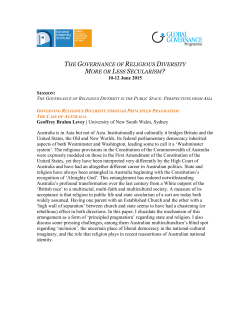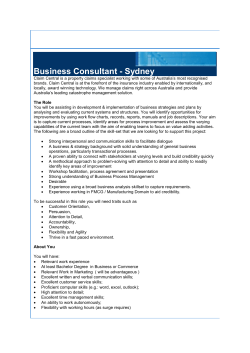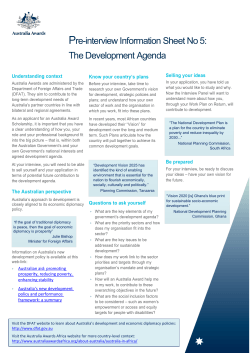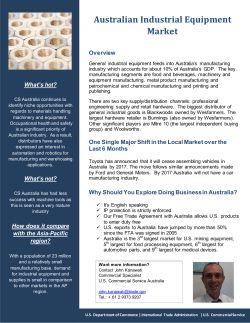
Australian Innovation and Manufacturing (AIM) Incentive
Australian Innovation and Manufacturing (AIM) Incentive Who cares about Australia’s future? WE DO April 2015 MEDICAL Contents Executive summary . . . . . . . . . . . . . . . . . . . . . . . . . . . . . . . . . . . . . . . . . . . . . . . . . . . . . . . . . . . . . . . . . . . . . . . . . . . . . . . . . . . . . 3 Australian manufacturing in 2015 and beyond. . . . . . . . . . . . . . . . . . . . . . . . . . . . . . . . . . . . . . . . . . . . . . . . . . . . . . . . . . . . . 4 Commercialising Australian innovation. . . . . . . . . . . . . . . . . . . . . . . . . . . . . . . . . . . . . . . . . . . . . . . . . . . . . . . . . . . . . . . . . . . . 5 AIM: working for jobs . . . . . . . . . . . . . . . . . . . . . . . . . . . . . . . . . . . . . . . . . . . . . . . . . . . . . . . . . . . . . . . . . . . . . . . . . . . . . . . . . . . 5 Standing still is not an option. . . . . . . . . . . . . . . . . . . . . . . . . . . . . . . . . . . . . . . . . . . . . . . . . . . . . . . . . . . . . . . . . . . . . . . . . . . . . 6 The AIM Incentive: an investment in Australia’s future . . . . . . . . . . . . . . . . . . . . . . . . . . . . . . . . . . . . . . . . . . . . . . . . . . . . . . 7 How would the AIM Incentive work?. . . . . . . . . . . . . . . . . . . . . . . . . . . . . . . . . . . . . . . . . . . . . . . . . . . . . . . . . . . . . . . . . . . . . . 8 The AIM Incentive in action . . . . . . . . . . . . . . . . . . . . . . . . . . . . . . . . . . . . . . . . . . . . . . . . . . . . . . . . . . . . . . . . . . . . . . . . . . . . . . 9 The bottom line. . . . . . . . . . . . . . . . . . . . . . . . . . . . . . . . . . . . . . . . . . . . . . . . . . . . . . . . . . . . . . . . . . . . . . . . . . . . . . . . . . . . . . . . 10 Final thoughts . . . . . . . . . . . . . . . . . . . . . . . . . . . . . . . . . . . . . . . . . . . . . . . . . . . . . . . . . . . . . . . . . . . . . . . . . . . . . . . . . . . . . . . . . 11 End notes . . . . . . . . . . . . . . . . . . . . . . . . . . . . . . . . . . . . . . . . . . . . . . . . . . . . . . . . . . . . . . . . . . . . . . . . . . . . . . . . . . . . . . . . . . . . . 11 Contact details . . . . . . . . . . . . . . . . . . . . . . . . . . . . . . . . . . . . . . . . . . . . . . . . . . . . . . . . . . . . . . . . . . . . . . . . . . . . . . . . . . . . . . . . 12 2 Executive summary To increase Australia’s global competiveness in innovation and manufacturing, a collaboration of Australian industry bodies and companies is urging the Federal Government to implement a ‘patent box’-style tax incentive, known as the Australian Innovation and Manufacturing (AIM) Incentive, which would offer a reduced tax rate on qualifying profit from intellectual property (IP). Australia already supports the research and development (R&D) phase of IP creation via the R&D Tax Incentive. However, this R&D is vulnerable to being sold, managed or manufactured overseas at the critical point due to a lack of supportive policy in Australia. This sees the resulting community and economic benefits – such as jobs, exports, manufacturing and clinical trials – head offshore with it. IP is highly-mobile and can be easily separated from the jurisdiction where it is developed, and its management and manufacturing migrated to low-tax jurisdictions that offer on-going incentives. If Australia is serious about becoming a knowledge-based economy, we need public policy that will encourage IP and its flow-on benefits to stay in Australia, thereby creating local wealth and jobs. Manufacturing is one of the major sources of innovation in Australia. While the sector makes up just 8% of the economy, it is responsible for a quarter of all investment in R&D. Innovation and manufacturing are different sides of the same coin. A constant push-pull operates, whereby innovation in product design encourages innovation in manufacturing processes, and vice versa. For this reason, the Harvard Business School advises against the separation of R&D and manufacturing1. The AIM Incentive is designed to address the gap that leaves our IP vulnerable and support Australian innovators and manufacturers, whilst retaining our home-grown IP. The implementation of the AIM Incentive should make the commercialisation of IP and manufacturing in Australia more genuinely viable for businesses, especially, if coupled with other measures, such as cutting red tape and increasing flexibility in industrial relations. There are currently 10 countries in the world (nine in Europe and China) that have adopted a patent box or ‘innovation box’ policy, with many more looking to introduce similar regimes in the future. Rather than a direct subsidy, the AIM Incentive would see the Federal Government provide tax relief based on the retention of IP ownership and associated commercialisation of IP in and from Australia. The AIM Incentive put forward in this paper has been designed not only as a tool to help innovators and manufacturers in Australia, but also to alleviate the financial pressures on the Australian Government by reducing the need for up-front direct subsidies. An excellent example of this kind of model working in practice is provided by the UK, where a 10% tax rate is applied (as opposed to the corporate tax rate of 21%) to qualifying profit. GlaxoSmithKline (GSK), one of the world’s largest pharmaceutical companies, has centralised its pharmaceutical IP in the UK and has announced a new investment of over AU$1.1 billion in the UK, including the first plant to be built by GSK in the UK in almost 40 years2. It is the AIM Incentive Stakeholder’s recommendation that the Federal Government consider adopting policy that will see the retention and commercialisation of IP in Australia, similar to the UK’s Patent Box model. The definition of qualifying IP for the AIM Incentive purposes is limited to patents, licenses to a patents and data exclusivity rights with an Australian connection or nexus. This would include certified innovation patents. Qualifying income for the lower tax rate should include the following: • license fees, royalties and milestone payments; • sales income from patented products; • contract manufacturing income; •income from the provision of a service reliant on a patented tool (to the extent the profit is attributable to the patent); and • income from patent enforcement. It is imperative that Australia takes action to remain competitive and relevant on the world stage, especially, when economies such as the UK, France, Switzerland and China are already reaping the benefits of their patent box regimes. If we are to maximise Australian innovation and reinvigorate the manufacturing sector in Australia, it is vital that the existing R&D Tax Incentive be complemented with an end-to-end tax regime that can secure Australia’s competitiveness for the future. 3 Australian manufacturing in 2015 and beyond Manufacturing feeds and clothes the families of more than a million Australian workers and accounts for more than $106 billion (or 8.3%) of our GDP3. However, hiding behind these figures is the sobering reality of an industry in crisis. Over the past six years, more than 100,000 manufacturing jobs have been lost, with a further 85,660 forecasted to go before 20184. Each job loss represents a personal tragedy for those people and families involved. There have been countless recent examples regarding the state of manufacturing in Australia. None more prevalent than Australia’s automotive industry. The associated job losses from the decline of the auto industry, show the damage the current climate is inflicting on a proud Australian workforce. Yet, it need not be like this. Structural reform in manufacturing is moving to high-value, low volume goods where we have a competitive advantage globally. Australia is a forward thinking nation that drives innovation; a fact reflected by the high number of patents Australians have generated in recent years. Over the past decade alone, 28,8115 patent applications have been filed. This success in innovation is linked to our traditional prowess in manufacturing. As any advanced manufacturer will tell you, most innovation with respect to products, ideas and advancements originates on the factory floor. Australia’s manufacturing future lies in a number of high-tech and medium-tech industries, such as pharmaceuticals, medical devices, scientific instruments and electronics, to name but a few. Australia needs a policy framework that supports all industries of the future, as well as traditional manufacturers, to maximise their potential for a stronger manufacturing and innovation sector in Australia. 4 Commercialising Australian innovation When it comes to fundamental discovery research, Australia is a legitimate and impressive global contributor, producing 3% of the world’s research publications with only 0.3% of the population. However, our ability to translate this strength into products to benefit the Australian community continues to fall short of expectation. For example, the 2014 INSEAD Global Innovation Index ranks Australia 10th in terms of innovation input and 17th in innovation output, but when these figures are converted to innovation efficiency ratio, Australia dives to 81 out of 143 countries assessed. This stark measure shows that Australians are brilliant at coming up with ideas but poor at translating them into locally produced products. Relative to the number of papers published and patents issued, Australia lags in key global commercialisation benchmarks and in creating significant public companies, commercial products, jobs and income. This means that, in addition to not gaining health benefits from those innovations, Australia misses out on the commercial and economic benefits that would have also become available. It is unfortunately a common story that as research findings are developed and near commercialisation, Australia loses the IP overseas. Australia already supports the research and development phase of innovation and IP creation via the R&D Tax Incentive, only to leave it vulnerable to being sold or manufactured overseas at the critical point. The resulting community and economic benefits go with it. IP is highly-mobile and can be easily separated from the jurisdiction where it was developed and migrated to lowtax jurisdictions or where there are on-going incentives. If Australia is serious about becoming a knowledge-based economy, we need public policy that will encourage IP commercialisation and the associated manufacturing and other spill over benefits to stay in Australia. AIM: working for jobs The Manufacturing Taskforce Report of the NonGovernment Members, stated that 106,775 Australian manufacturing jobs had been lost between 2006 and 2012 and it is anticipated that another 85,600 jobs will go before 2017. That is the loss of almost 200,000 jobs over a 10 year period. The greatest contribution industry can make to an economy is being successful. The AIM Incentive will not only safeguard manufacturing jobs but also contribute to maintaining a robust, broad-based Australian economy that increases employment opportunities. According to the Australian Bureau of Statistics, 276,3007 students completed their schooling in 2014. With the manufacturing sector accounting for 8.4%8 of the total labour force, that’s more than 23,000 eighteen-year-olds who are destined to work in the manufacturing sector. It is, therefore, imperative that we take action now to foster Australia’s future innovation and manufacturing talent. In the past decade alone, manufacturing has gone from being Australia’s second largest industry employer to the fourth and the unemployment rate for people who hold Certificate I/II qualifications is 9.9%9 - nearly double the current national unemployment rate. Innovation that emerges from our knowledge and manufacturing sectors also fuels growth within the service sector, because intermediary goods – the machines used by services – drive service sector productivity. In the United States, for example, every dollar of manufacturing output requires 19 cents of services10. And in some manufacturing sectors, more than half of all employees work in service roles - such as R&D engineers and office-support staff. By implementing the AIM Incentive, policy makers have the opportunity to provide companies with the additional resources required to invest in their growth, whilst allowing them to produce more quality products and potentially employ additional staff. Rather than a direct subsidy, the AIM Incentive would see the Federal Government provide tax relief based on the retention of IP ownership and associated commercialisation of IP in and from Australia. It would also support companies that make goods outside Australia where significant ‘valueadd’ activities are performed in Australia and the net benefit from its sales will benefit the Australian economy. 5 Standing still is not an option Recognising the importance of innovation to Australia’s future, policy makers have already taken one important step by implementing the R&D Tax Incentive. This Incentive is an effective tool in promoting investment in research and encouraging collaboration between business and research centres in the development of new IP. The benefits of R&D Tax Incentives are widely recognised globally, with 30 countries, including the top 10 global manufacturing countries, now offering R&D tax incentives. As R&D incentives become more commonplace around the world, a number of governments have demonstrated that to stay ahead, it is necessary to address the other side of the innovation coin – commercialisation, including manufacturing. Manufacturing is an important way of translating IP into benefit to society. If IP just remains at an academic level or just sits in someone’s drawer – it is of limited value to society. There are currently 10 countries in the world (nine in Europe and China) that have adopted a ‘patent’ or ‘innovation ’-style policy with many more looking to introduce similar regimes in the future. This policy is intended to build upon the benefits derived from the investment in the R&D phase by encouraging companies to locate all activity associated with the development, manufacture and exploitation of that IP (and hence jobs) within the home country. The UK’s version of the patent box regime offers companies a 10% tax rate (as opposed to the general corporate tax rate of 21%), on the income streams derived from qualifying IP commercialised in the UK 6 (whether through licensing, sale of products manufactured in the UK or by providing services using patented technology). The UK’s patent box is an excellent example of the kind of stimulus such a measure can provide in practice. GlaxoSmithKline (GSK), one of the world’s largest pharmaceutical companies, has centralised its pharmaceutical IP in the UK and has announced a new investment of over AU$1.1 billion in the UK, including the first plant to be built by GSK in the UK in almost 40 years2. It is imperative that Australia takes action to remain competitive and relevant on the world stage, especially, when economies such as the UK, France, Switzerland and China are already reaping the benefits of their patent box regimes. If we are to maximise Australian innovation and reinvigorate the manufacturing sector in Australia, it is vital that the existing R&D Tax Incentive be complemented with a commercialisation tax regime that can secure Australia’s competitiveness for the future. The implementation of the AIM Incentive should make the commercialisation of IP and manufacturing in Australia more genuinely viable for businesses, especially, if coupled with other measures, such as cutting red tape and increasing flexibility in industrial relations. One of the purposes of the AIM Incentive is to increase the commercial viability of taking R&D-based technology to market and undertaking all of the required steps in a business life cycle in or from Australia. The AIM Incentive: an investment in Australia’s future The goal of the AIM Incentive is to stimulate commercialisation of innovation and manufacturing within Australia. Currently, the Australian company tax rate sits at 30%. In the 2014 Federal Budget a 1.5% reduction was announced, to take effect from 1 July 2015. Despite the proposed drop, it is still one of the highest in the developed world. This challenge, along with other factors, such as high labour and operating costs, combined with the departure of some of our best minds to overseas markets and a lack of foreign investment, have all contributed to a bleak outlook for Australian innovation industries. The AIM Incentive put forward in this paper has been designed not only as a tool to help innovators and manufacturers in Australia, but also to alleviate the financial pressures on the Australian Government by reducing the need for up-front direct subsidies. The proposed AIM Incentive is closely based on the UK Patent Box model, including a number of recent amendments that were presented to the OECD and discussed at the 2014 G20 Summit. Early evidence of the current UK model in action is proving that it is highly effective and is achieving its objectives. The proposed AIM Incentive model has been designed to stem the flow of manufacturing off-shore whilst providing a solution for future jobs for Australians and a competitive advantage for Australian companies. The design of the AIM Incentive would provide opportunities for Australian-based businesses to reach maximum effectiveness/impact in achieving their objectives. At the same time, it should also be robust, so that it is not open to abuse, can be enforced and be efficient in terms of cost of compliance/use. Companies qualifying for the AIM Incentive are also likely to be performing significant R&D activities and, therefore, would be expected to qualify for the R&D Tax Incentive. The AIM Incentive has been designed to complement the R&D Tax Incentive and companies claiming the R&D Tax Incentive should not be penalised when calculating their profits for the AIM Incentive purposes. However, given that it would be desirable to attract overseas IP and associated manufacturing to Australia, to qualify for the AIM Incentive in this instance, the IP in question would need to be coupled with Australian developed IP to produce locally manufactured products. 7 How would the AIM Incentive work? Implementation of the AIM Incentive would make the commercialisation of IP and manufacturing in Australia more genuinely viable for businesses. It will provide a reduction in the tax payable on any profits derived from the commercialisation of qualifying IP in Australia (either via licensing or manufacturing and sale of products incorporating qualifying IP). Qualifying IP under the AIM Incentive would be patents (including certified innovation patents), data exclusivity periods and corresponding licences to those patents with an Australian nexus. Limiting the AIM Incentive to this form of IP would allow for ease of administration, as it would not include non-registered and often subjective types of IP, such as ‘know-how’. Qualifying IP would have to have the requisite nexus with Australia. One of the purposes of the AIM Incentive is to increase the commercial viability of taking R&D-based technology to market and undertaking the required steps in a business life cycle in and/or from Australia. Broadly, qualifying IP profit would be taxed at the lower rate (e.g. 10%) with the standard corporate tax rate to be applied to other income. The AIM Incentive would apply to income generated from ‘qualifying IP’ with an Australian nexus, which should include the following: • license fees; •royalties; • milestone payments; • sales income from patented products; •contract manufacturing income; •income from the provision of a service reliant on a patented tool (to the extent the profit is attributable to the patent); and • income from patent enforcement. Anti-abuse Anti-abuse features should be incorporated to ensure that the AIM Incentive is properly targeted and applied. Based on the UK Patent Box regime, the following situations would not be covered by the AIM Incentive: •where a functionally irrelevant patent is incorporated into a product with the sole purpose of achieving the AIM Incentive eligibility; •commercially irrelevant grant of exclusivity with the sole purpose of achieving the AIM Incentive eligibility; and 8 •any scheme designed to inflate artificially qualifying IP income or qualifying AIM Incentive profits. Reasonable and commercially-appropriate steps to restructure corporate arrangements to take advantage of the AIM Incentive should be considered acceptable, as the AIM Incentive’s objective is to incentivise companies to keep their IP in Australia. As a further integrity measure, companies could be required to prepare audited accounts to be eligible for the AIM Incentive. It is possible to phase in the AIM Incentive, similarly to the way it was done in the UK. That is, initially, the incentive would cover a percentage of qualifying IP profit, with the percentage increasing from year to year until it reaches 100% of the qualified profits. This would allow the benefits of the AIM Incentive to catch up with the cost associated with the reduced revenues collected by the government. The AIM Incentive in action The following examples provide a high-level overview for illustrative purposes of the difference the AIM Incentive could make to a business. Business summary without AIM Incentive ($000’s) Total sales of qualifying products* 88,000 Total revenue of non-qualifying products 35,000 Total Revenue Business summary with AIM Incentive ($000’s) Qualifying Non-qualifying revenue revenue 88,000 Costs related to qualifying products 50,000 50,000 Costs related to non-qualifying products 17,000 Profit Australian corporate tax rate 56,000 88,000 88,000 123,000 38,000 30% Business total 35,000 35,000 35,000 123,000 50,000 17,000 17,000 18,000 56,000 30% AIM Incentive tax rate 10% Company tax 16,800 Profit after tax 39,200 3,800 5,400 9,200 46,800 Additional funds available to reinvest back into the business: $7,600,000 * i.e. license fees, royalties and milestone payments, sales income from patented products; contract manufacturing income, income from the provision of a service reliant on a patented tool (to the extent the profit is attributable to the patent) and income from patent enforcement. 9 The bottom line It is widely acknowledged that building Australia’s capacity as a technologically innovative country is vital for our economic future. The AIM Incentive is focused on patents rather than other forms of IP as they have a strong link to R&D and manufacturing in a wide range of sectors and will contribute to the integrity of the AIM Incentive. In a time where technological innovation, knowledge and networking are the drivers of productivity, Australia has great expertise in many areas that should be leveraged to our economy’s advantage. Australia needs to reverse the current skills shortage and loss of industry jobs by offering competitive support that is so readily available outside of Australia. By harnessing the skills that workers already have and upgrading and utilising them in new industries, as well as training new members of the workforce, there is an opportunity to keep Australia’s diverse manufacturing tradition alive. For Australia to compete on a global level, the development of greater economic diversity should be 10 seen as a high priority and with the introduction of policy, such as the AIM Incentive, it fosters opportunities, that are currently deteriorating, to future generations entering the workforce. The increase in employment due to greater investment by companies would increase income tax collections and national insurance yields, whilst concurrently reducing the welfare bill. PwC in the UK estimated that a fifth of the new jobs created as a result of the R&D Incentive alone would result in a reduction in welfare claims by $5,000 per case . Introducing the AIM Incentive to cover commercialisation of IP could result in a dramatic enhancement of Australia’s economy. All of the stated benefits would help create a stronger national economy that is more resilient to change and provides a platform for greater innovation and development to protect the needs of Australians in the coming years. As a nation, we cannot afford to lose our remaining manufacturing skills and capabilities. Innovation and manufacturing need to be nurtured, so that they can once again excel and form robust pillars of the Australian economy. Final thoughts Manufacturing and innovation have a proud history and, if supported, could have a transformational impact on the future of Australia’s economy. They offer opportunities for many Australians to pursue their dreams, due to the diversity of skills and people required to operate in different industries. The introduction of the AIM Incentive would provide the optimal policy framework in which to turn Australian ideas into realities that benefit Australia. The AIM Incentive would benefit companies for as long as they exploit their IP in and from Australia. The elegance of such a solution is that it also helps to reduce the financial pressures on the Australian Government by reducing the need for up-front direct subsidies. The AIM Incentive would not only safeguard manufacturing jobs, help retain our IP and facilitate innovation; it would also contribute to Australia maintaining a robust, broad-based economy, in turn increasing employment. The time has come for Australia to leverage its skills in innovation and become a leader in manufacturing once more. Let us not wait for the next 85,600 jobs to be lost, or for the patent box concept to become a global norm. Let Australia be proactive and enact a policy that supports the companies that are contributing to our broad-based economy with new and sustainable innovations. End notes 1.Harvard Business Review, ‘Does America Really Need Manufacturing?’ 2.Daily Telegraph, ‘Budget 2012: GlaxoSmithKline to invest £500m in UK and create 1,000 jobs after cut in patent profits tax’ 3.Prime Minister’s Manufacturing Taskforce, Report of the Non-Government Members Manufacturing: Positions, Pressures and Prospects’ 4.Ibid 5. IP Australia website 6.Prime Minister’s Manufacturing Taskforce, Report of the Non-Government Members, ‘Manufacturing: Positions, Pressures and Prospects’ 7.Australian Bureau of Statistics – Schools, Australia – Catalogue No. 6227.0 8.Australian Bureau of Statistics 2013 labor Statistics Brief. Catalogue No. 6104.0 9.Australian Bureau of Statistics 2013 labour Statistics Brief. Catalogue No. 6104.0 10. Deloitte, ‘2014 Global Survey of R&D Tax Incentives’ 11. PWC, ‘R&D tax relief – an economic study, 2011’ List of Countries that currently have a patent or innovation box regime: Belgium, China, France, Hungary, Italy, Luxembourg, The Netherlands, Spain, Switzerland, United Kingdom. List of Countries that currently have an R&D tax incentive: Brazil, Canada, China, Czech Republic, France; Hungary, India, Ireland, Israel, Italy, Japan, Malaysia, Mexico, The Netherlands, Poland, Portugal, Russia, Singapore, South Africa, South Korea, Spain, Turkey, United Kingdom, United States. 11 Contact details AusBiotech Dr. Anna Lavelle – Chief Executive Officer E-mail: alavelle@ausbiotech.org Phone: 03 9828 1400 Cook Medical Barry Thomas – Managing Director E-mail: barry.thomas@cookmedical.com Phone: 07 3434 6000 Export Council of Australia Lisa McAuley – Chief Executive Officer E-mail: lisamcauley@export.org.au Phone: 02 8243 7400 Medical Technology Association of Australia Susi Tegen – Chief Executive E-mail: stegen@mtaa.org.au Phone: 02 9900 0650 COOK 03/2015
© Copyright 2025









